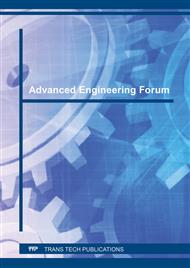[1]
W. Cai, L. Huang, N. Wu, Class E Power Amplifier for Wireless Medical Sensor Network, International Journal of Enhanced Research in Science, Technology & Engineering, 5 (2016) 6.
Google Scholar
[2]
D.R. Monteiro, L.F. Gorup, A.S. Takamiya, A.C. Ruvollo-Filho, E.R. d. Camargo, D.B. Barbosa, The growing importance of materials that prevent microbial adhesion: antimicrobial effect of medical devices containing silver, International Journal of Antimicrobial Agents, 34 (2009).
DOI: 10.1016/j.ijantimicag.2009.01.017
Google Scholar
[3]
Y. Cao, J. Weiss, J. Youngblood, R. Moon, P. Zavattieri, Performance-enhanced cementitious materials by cellulose nanocrystal additions, Production and Applications of Cellulose Nanomaterials, (2013) 2.
DOI: 10.1016/b978-0-08-100957-4.00020-6
Google Scholar
[4]
Y. Cao, P. Zavaterri, J. Youngblood, R. Moon, J. Weiss, The influence of cellulose nanocrystal additions on the performance of cement paste, Cement and Concrete Composites, 56 (2015) 11.
DOI: 10.1016/j.cemconcomp.2014.11.008
Google Scholar
[5]
W. Cai, L. Huang, W. Wen, 2. 4GHZ Class AB Power Amplifier for Wireless Medical Sensor Network, International Journal of Enhanced Research in Science, Technology & Engineering, 5 (2016) 5.
Google Scholar
[6]
W. Cai, B. Wu, N. Wu, 2. 4 GHz Class F Power Amplifier for Healthcare Application, International Journal of Computer Science and Information Technologies, 7 (2016) 5.
Google Scholar
[7]
W. Cai, F. Shi, DESIGN OF LOW POWER MEDICAL DEVICE, International Journal of VLSI design & Communication Systems (VLSICS), 8 (2017) 7.
DOI: 10.5121/vlsic.2017.8201
Google Scholar
[8]
W. Cai, F. Shi, Design of Low Power Si Based DPA for Medical Device, International Journal of Electronics Communication and Computer Engineering, 8 (2017) 3.
Google Scholar
[9]
S. Sun, M. Brandt, M.S. Dargusch, Thermally enhanced machining of hard-to-machine materials-A review, International Journal of Machine Tools & Manufacture, 50 (2010) 18.
DOI: 10.1016/j.ijmachtools.2010.04.008
Google Scholar
[10]
K. Sobolev, Z. Lin, Y. Cao, H. Sun, I. Flores-Vivian, T. Rushing, T. Cummins, W.J. Weiss, The influence of mechanical activation by vibro-milling on the early-age hydration and strength development of cement, Cement and Concrete Composites, 71 (2016).
DOI: 10.1016/j.cemconcomp.2016.04.010
Google Scholar
[11]
P. Bizi-Bandoki, S. Benayoun, S. Valette, B. Beaugiraud, E. Audouard, Modifications of roughness and wettability properties of metals induced by femtosecond laser treatment, Applied Surface Science, 257 (2011) 6.
DOI: 10.1016/j.apsusc.2010.12.089
Google Scholar
[12]
Y. Cao, Nano-modification for high performance cement composites with cellulose nanocrystals and carbon nanotubes, PhD Dissertation, (2014).
Google Scholar
[13]
Y. Cao, N. Tian, D. Bahr, P.D. Zavattieri, J. Youngblood, R.J. Moon, J. Weiss, The influence of cellulose nanocrystals on the microstructure of cement paste, Cement and Concrete Composites, 76 (2016) 10.
DOI: 10.1016/j.cemconcomp.2016.09.008
Google Scholar
[14]
G. Wu, J. -M. Yang, The mechanical behavior of GLARE laminates for aircraft structures, Journal of The Minerals, Metals & Materials Society, 57 (2005) 8.
Google Scholar
[15]
S.L. Lemanski, G.N. Nurick, G.S. Langdon, M.S. Simmons, W.J. Cantwell, G.K. Schleyer, Understanding the behaviour of fibre metal laminates subjected to localised blast loading, Composite Structures, 76 (2006) 6.
DOI: 10.1016/j.compstruct.2006.06.012
Google Scholar
[16]
E.C. Botelho, R.A. Silva, L.C. Pardini, M.C. Rezende, A review on the development and properties of continuous fiber/epoxy/aluminum hybrid composites for aircraft structures, Materials Research, 9 (2006) 10.
DOI: 10.1590/s1516-14392006000300002
Google Scholar
[17]
Y. Cao, P. Zavattieri, J. Youngblood, R. Moon, J. Weiss, The relationship between cellulose nanocrystal dispersion and strength, Construction and Building Materials, 119 (2016) 9.
DOI: 10.1016/j.conbuildmat.2016.03.077
Google Scholar
[18]
S.E. Moussavi-Torshizi, S. Dariushi, M. Sadighi, P. Safarpour, A study on tensile properties of a novel fiber/metal laminates, Materials Science and Engineering: A, 527 (2010) 6.
DOI: 10.1016/j.msea.2010.04.028
Google Scholar
[19]
W.D. Callister, D.G.R. Jr., Materials Science and Engineering: An Introduction, 9th Edition, John Wiley & Sons, Incorporated, (2014).
Google Scholar
[20]
J. -M. Berthelot, Composite Materials Mechanical Behavior and Structural Analysis, Springer, (1999).
Google Scholar
[21]
H.F. Wu, L.L. Wu, W.J. Slagter, J.L. Verolme, Use of rule of mixtures and metal volume fraction for mechanical property predictions of fibre-reinforced aluminium laminates, Journal of Materials Science, 29 (1994) 9.
DOI: 10.1007/bf00376282
Google Scholar


